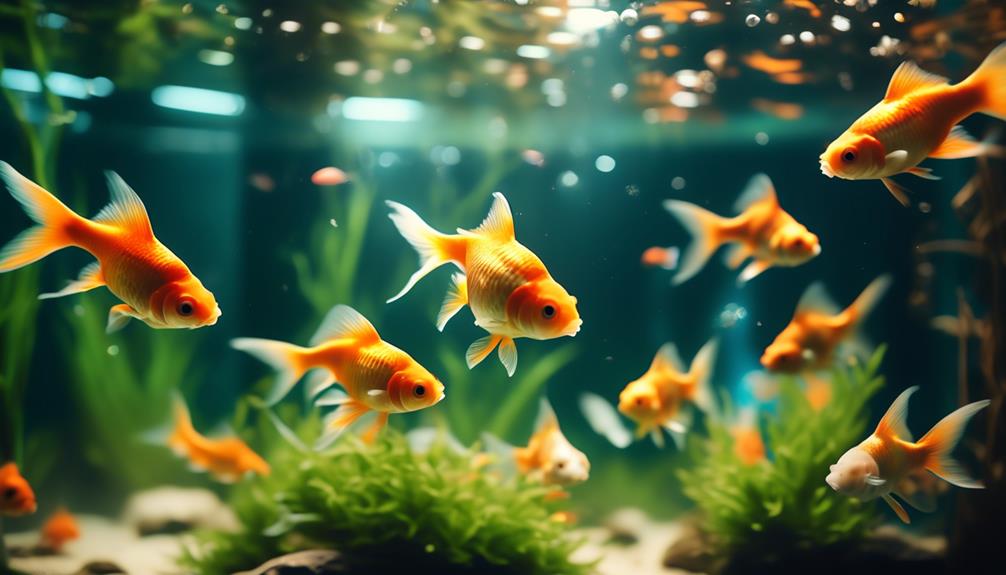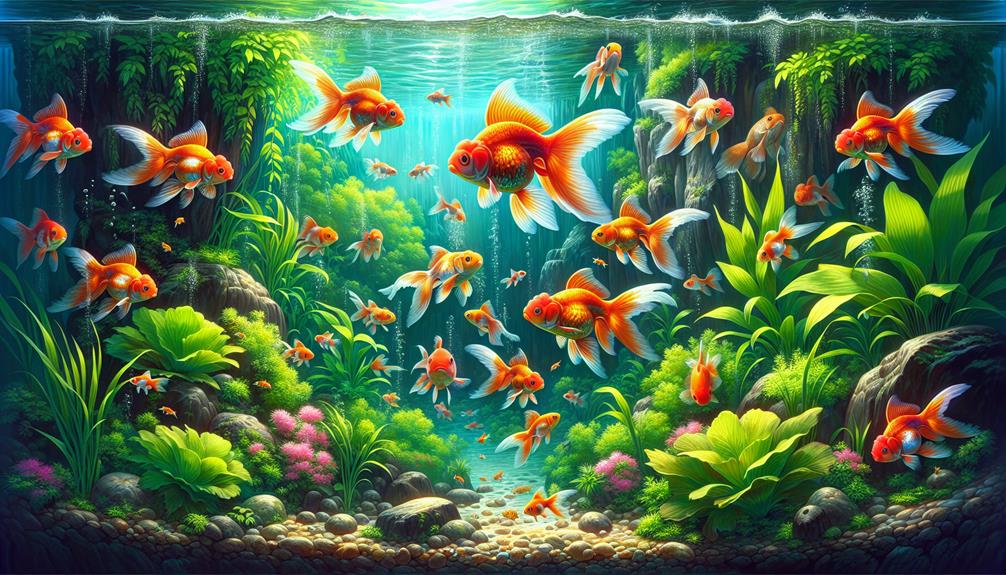Keeping goldfish healthy is not as simple as it may seem. It requires a comprehensive understanding of their specific needs and careful attention to various factors that can affect their well-being.
From the size of the tank and its maintenance to feeding habits and water quality, there are secrets to uncover in order to ensure the optimal care for these beloved aquatic pets.
In this discussion, we will explore the secrets behind maintaining healthy goldfish, revealing valuable insights that will help you provide the best possible care for your finned companions.
So, get ready to dive into the world of goldfish care and unveil the secrets that will keep your goldfish thriving and happy.
Key Takeaways
- Proper tank size is crucial for the health of goldfish, with a recommended minimum of 20 gallons per fish.
- Good filtration is necessary to handle goldfish waste and maintain water quality.
- Feeding a clean diet with high-quality food and avoiding overfeeding helps reduce tank maintenance.
- Regular monitoring of water quality, observing goldfish behavior, and maintaining the tank are essential for keeping goldfish healthy.
Tank Size and Maintenance Recommendations
In order to provide a healthy and suitable environment for goldfish, it is crucial to consider tank size and maintenance recommendations. Choosing the right tank size is essential for the well-being of goldfish. It is recommended to have at least 20 gallons of water volume per goldfish, and an additional 10 gallons for every additional goldfish. Smaller tanks require more frequent water changes, while larger tanks make maintenance more manageable. Goldfish prefer wider tanks with more surface area for swimming.
Regular water changes are of utmost importance in maintaining a healthy goldfish tank. Water changes help remove excess waste, toxins, and maintain water quality. It is recommended to change around 20-30% of the water every week to keep the water clean and balanced. This helps prevent the accumulation of harmful substances and keeps the goldfish environment safe.
Heating and Filtration Tips
To ensure optimal health and well-being for your goldfish, it is important to implement effective heating and filtration strategies in their tank.
Goldfish are cold water fish and can live in temperatures of 50-70°F (10-21°C). If the room temperature is suitable, there is no need for a heater.
Filtration is crucial to handle goldfish waste. When choosing a filtration system, consider hang-on-back filters or sponge filters, as these are commonly used and effective.
Good surface agitation is necessary for increased oxygenation, which can be achieved by using a filter with adjustable flow rate or adding an air stone.
Additionally, regular water changes are important for maintaining water quality. By removing a portion of the water and replacing it with fresh, conditioned water, you can minimize the build-up of harmful substances and ensure a clean and healthy environment for your goldfish.
Feeding Guidelines for Healthy Goldfish

Sustaining the optimal health of goldfish requires implementing a well-balanced and nutritious feeding regimen. Goldfish feeding schedules play a crucial role in maintaining their overall well-being.
A clean diet offers numerous benefits, including improved digestion, enhanced immune system, and reduced tank maintenance. It is important to provide goldfish with high-quality food to minimize tank dirtiness and the need for frequent water changes. Recommended foods for goldfish include frozen brine shrimp, high-quality pellets, and Repashy gel foods.
It is essential to avoid overfeeding, as it can lead to bloat and other health issues. Instead, aim to give two small meals per day, as feeding smaller meals twice a day is better than one large meal.
Managing Cloudy Water and Water Quality
When ensuring the optimal health of goldfish, it is crucial to address issues such as managing cloudy water and maintaining water quality. Cloudy water can be caused by bacterial bloom in newly set up tanks or after adding new goldfish. It is important to wait patiently without making drastic changes for the bacteria cloud to disappear. Cloudiness due to excessive particulate requires a water change and filter cleaning. Regularly testing water for nitrates is essential, and a water change is necessary when nitrates measure above 50 ppm. Live aquarium plants can help absorb nitrogen waste and reduce the frequency of maintenance. Preventing water quality issues can be achieved by maintaining proper filtration, providing good surface agitation for increased oxygenation, and feeding goldfish with a clean diet of frozen foods or duckweed. A three-column, five-row table is provided below to summarize the causes of cloudy water and the steps for preventing water quality issues:
| Causes of Cloudy Water | Preventing Water Quality Issues |
|---|---|
| Bacterial bloom | Wait patiently for the cloud to disappear |
| Excessive particulate matter | Perform water change and filter cleaning |
| High nitrate levels | Regularly test water and change when necessary |
| Lack of live aquarium plants | Add live plants to absorb nitrogen waste |
| Poor filtration | Maintain proper filtration and surface agitation |
Behavior and Care for Happy Goldfish

Goldfish behavior and care play a crucial role in maintaining the happiness and overall well-being of these aquatic pets. It is important to observe goldfish daily to learn their habits and identify any abnormal behavior. This includes looking for physical irregularities and signs of disease.
In addition, monitoring water parameters such as temperature, pH, and nitrates on a weekly basis is crucial for a successful tank. By regularly testing the water and treating goldfish with proper care, including regular maintenance and water quality testing, owners can ensure the health of their goldfish.
Identifying common goldfish diseases is also essential in providing appropriate treatment. By staying vigilant and proactive in monitoring both behavior and water quality, goldfish owners can ensure the happiness and well-being of their beloved pets.
Frequently Asked Questions
How Do I Prevent My Goldfish From Getting Bored?
To prevent goldfish from getting bored, it is important to keep them entertained with innovative aquarium decorations. Providing objects such as caves, plants, and toys can stimulate their natural behaviors and provide mental stimulation, promoting their overall well-being.
Can Goldfish Be Kept in a Tank With Other Types of Fish?
Goldfish should be kept in a species-only tank as they may not be compatible with other types of fish. Keeping goldfish in a separate tank provides numerous benefits, including reducing the risk of aggression, disease transmission, and maintaining optimal water parameters for their specific needs.
How Often Should I Clean the Tank?
To maintain water quality in a goldfish tank, regular cleaning is essential. It is recommended to clean the tank once every 1-2 weeks, depending on the tank size and number of goldfish. Choosing the right size tank is crucial for the health of your goldfish.
Can Goldfish Live in Outdoor Ponds?
Goldfish can live in outdoor ponds, but proper maintenance is necessary. Outdoor ponds provide a larger and more natural environment for goldfish, allowing for more swimming space. Regular water testing, filtration, and monitoring of temperature and oxygen levels are essential for their well-being.
What Should I Do if My Goldfish Stops Eating?
To encourage appetite in goldfish and address weight loss, assess water quality and temperature, monitor behavior for signs of illness, and offer high-quality food in smaller, frequent meals. Consult a veterinarian if the issue persists.
Conclusion
In conclusion, maintaining healthy goldfish requires careful attention to various factors. These factors include tank size, heating and filtration, feeding practices, and water quality management.
By ensuring the appropriate tank size and regular maintenance, goldfish owners can provide a suitable living environment for their pets. This includes giving the fish enough space to swim and grow comfortably.
Providing the correct temperature range is also crucial. Goldfish are cold-water fish and thrive in temperatures between 65-72 degrees Fahrenheit. It is important to use a heater to maintain a consistent temperature for the fish.
Effective filtration is another essential aspect of goldfish care. A good filtration system helps to remove waste and toxins from the water, keeping it clean and healthy for the fish. Regular cleaning and maintenance of the filter are necessary to ensure its optimal performance.
Feeding practices play a significant role in the health of goldfish. A balanced diet that includes a variety of high-quality pellets, flakes, and occasional treats is recommended. Overfeeding should be avoided as it can lead to obesity and other health issues.
Water quality management is crucial for goldfish health. Regular water changes and testing for parameters such as ammonia, nitrite, and nitrate levels are necessary to maintain a stable and clean environment. Monitoring the behavior of the fish is also important, as any changes in activity or appearance may indicate a problem that needs to be addressed.
By addressing these factors and understanding the specific needs of goldfish, owners can promote the well-being and longevity of their beloved pets. Remember, a happy goldfish is a healthy goldfish.

